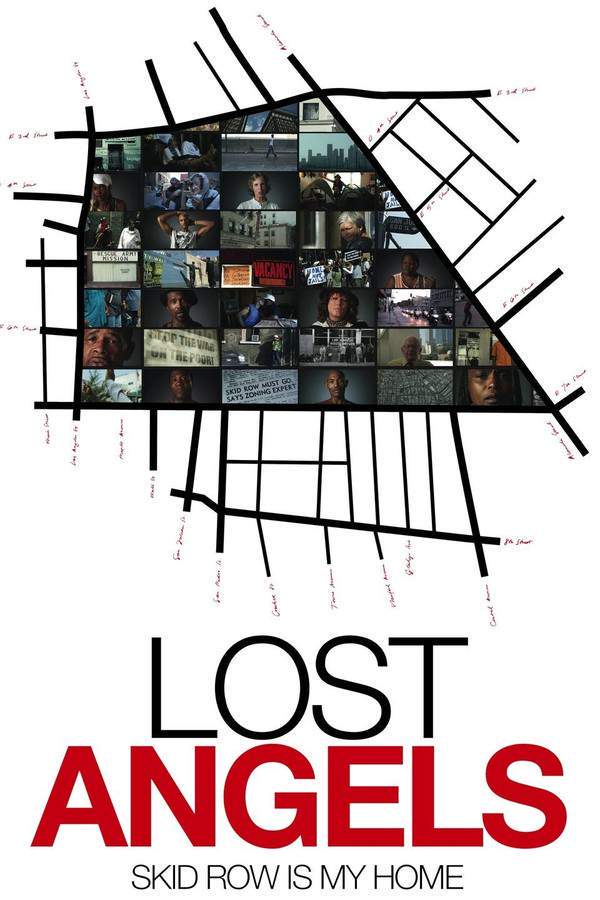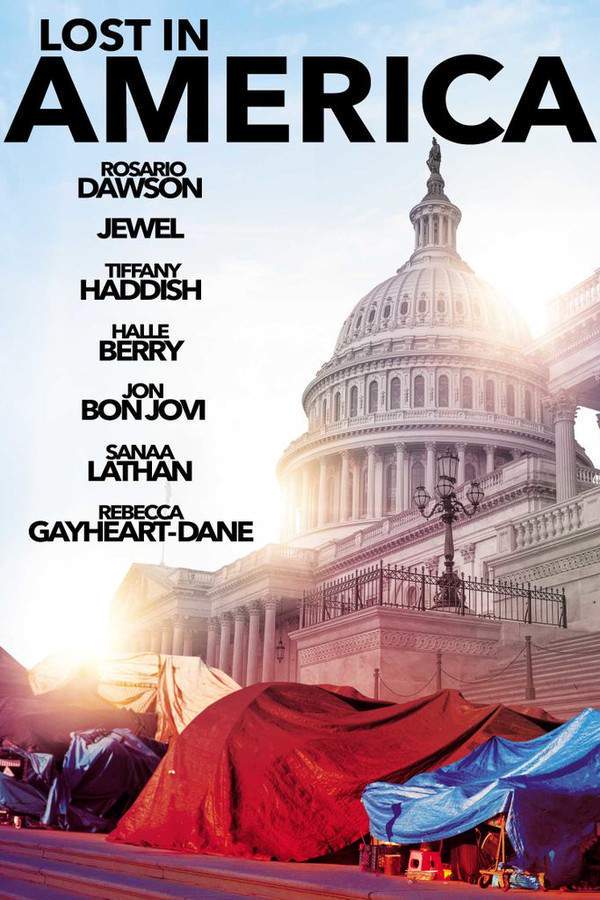
Lost Angels: Skid Row Is My Home 2012
Directed by

Thomas Q. Napper
Made by
Paramount Pictures
Test your knowledge of Lost Angels: Skid Row Is My Home with our quiz!
Lost Angels: Skid Row Is My Home Plot Summary
Read the complete plot summary and ending explained for Lost Angels: Skid Row Is My Home (2012). From turning points to emotional moments, uncover what really happened and why it matters.
In 2010, Los Angeles, a staggering 10,000 individuals grappling with mental illness reside amidst the challenging environment of Skid Row, a mere one-square mile of Downtown. This area, much like numerous others around the United States, is home to many whose existence is often overlooked. These individuals—often forgotten and unsupported—are visible on the streets, near storefronts, and resting on benches, embodying a community that remains largely invisible.
Directed by Thomas Nappers, LOST ANGELS presents an unflinching yet heartwarming account of eight extraordinary individuals who have carved out a semblance of life for themselves in this unique enclave. Among them is Lee Anne, a former Southern mom, who now devotes her evenings to feeding the stray cats that roam Skid Row. Alongside her is K.K., a former boxer known for his charisma, who fiercely protects Lee Anne while also serving as a compelling historian of the area.
The film introduces Bam Bam, a vibrant transgender figure whose bold demeanor obscures a profound insight into the nature of mental illness. Detroit, a mother of three, abandoned her family in search of something better but found herself without a roof over her head, still striving for personal healing. We also meet O.G., a committed street sweeper and self-appointed chronicler of the neighborhood, as well as Linda Harris, who faces social ostracism due to a rare skin condition yet radiates an inner grace in her community.
General Dogon, a radical ex-convict, has rallied a passionate group of community members to defend civil rights on Skid Row, while Danny Harris, a former Olympic athlete, demonstrates resilience after hitting rock bottom in the shelters, courageously rising from his struggles on the Row.
LOST ANGELS also scrutinizes a neighborhood under siege from gentrification and a police force intent on criminalizing homelessness. It highlights the severe alterations to the mental health care system that have contributed to the current crisis. With the support of dedicated advocates and organizers who fight for the rights of society’s marginalized, the residents of Skid Row have come together to resist and reclaim their dignity.
Narrated by Catherine Keener, this insightful documentary sheds light on the proactive strategies that are aiding many in overcoming mental health challenges and substance abuse. For countless individuals, Skid Row emerges as, arguably, the last refuge where they can seek support and construct a meaningful life—illustrating the profound notion that sometimes, home is indeed where the help is.
Lost Angels: Skid Row Is My Home Timeline
Follow the complete movie timeline of Lost Angels: Skid Row Is My Home (2012) with every major event in chronological order. Great for understanding complex plots and story progression.
Introduction to Skid Row
In 2010, Los Angeles, the film presents Skid Row, a densely populated area where approximately 10,000 individuals struggling with mental illness reside. This stark environment is emblematic of forgotten communities across the nation, where many individuals are often overlooked and unsupported.
Life on Skid Row
The documentary showcases the daily lives of individuals on Skid Row, emphasizing the challenges they face while trying to survive in a demanding environment. Many inhabit the streets, benches, and storefronts, revealing a sense of community that is largely invisible to the outside world.
Lee Anne's Compassion
Lee Anne, a former Southern mom, is introduced as a compassionate individual who spends her evenings feeding stray cats on Skid Row. Her nurturing character shines through, as she also creates a sense of warmth amid the harshness of street life.
K.K. the Protector
K.K. is portrayed as a charismatic former boxer who fiercely protects Lee Anne in their shared environment. His role extends beyond guardianship, as he serves as a storyteller and historian, capturing the essence of Skid Row's community.
Bam Bam's Insight
Bam Bam, a vibrant transgender figure, brings a bold presence to the narrative, showcasing how appearances can be deceptive. Beneath a confident exterior lies profound insight into the struggles of mental health, exemplifying the complexities of identity and survival on Skid Row.
Detroit's Journey
Detroit, a mother of three, embarked on a quest for a better life but instead found herself homeless. Her story is one of searching for personal healing in the chaos of Skid Row, reflecting the intricacies of hope and disillusionment.
O.G. the Chronicler
O.G. emerges as a dedicated street sweeper, taking it upon himself to document the lives and histories of those in Skid Row. His commitment to preserving the neighborhood's narrative highlights the importance of memory and community identity.
Linda's Grace
Linda Harris stands out as a resilient figure who faces discrimination due to a rare skin condition. Her presence in the community symbolizes grace and strength amid social ostracism, showcasing the variety of struggles faced by the residents.
General Dogon's Activism
General Dogon, an ex-convict, leads a passionate movement among Skid Row's residents to defend their civil rights. His activism highlights the community's collective desire to reclaim their dignity in the face of adversity and systemic challenges.
Danny's Resilience
Danny Harris, a former Olympic athlete, represents the spirit of recovery as he rises from the depths of the shelters. His journey showcases resilience, as he navigates the complexities of homelessness and strives for a better life despite the odds.
Gentrification Challenges
As the documentary unfolds, it scrutinizes the impact of gentrification on Skid Row, a neighborhood grappling with external pressures to change. The struggle between maintaining the community's identity and the encroaching forces of development becomes a pivotal theme.
Police and Homelessness
The film addresses the challenges posed by a police force that often criminalizes homelessness, amplifying the struggles faced by Skid Row's residents. This policing approach exacerbates the isolation and marginalization of the individuals living in this vulnerable area.
Advocacy Efforts
Dedicated advocates and organizers play a crucial role in fighting for the rights of marginalized individuals on Skid Row. Their relentless efforts to provide support and resources are essential in the community's struggle against systemic neglect.
Finding Home
The film concludes by offering a poignant message about seeking help and finding home. For many of Skid Row's residents, this area represents a sanctuary where they can build a meaningful life, reflecting the notion that home is often defined by support and acceptance.
Lost Angels: Skid Row Is My Home Characters
Explore all characters from Lost Angels: Skid Row Is My Home (2012). Get detailed profiles with their roles, arcs, and key relationships explained.
Lee Anne
Lee Anne is a former Southern mother who has found her purpose in caring for stray cats on Skid Row. Her nurturing spirit and determination to bring comfort to animals reflect her deep compassion, even amidst her struggles. She represents the often-overlooked humanity within the community of Skid Row.
K.K.
K.K. is a charismatic former boxer who protects Lee Anne and serves as a historian of Skid Row. His larger-than-life personality adds vibrancy to the narrative while showcasing his commitment to the community's struggles. K.K. embodies resilience and the fight for dignity in a challenging environment.
Bam Bam
Bam Bam is a vibrant transgender individual whose boldness conceals a deeper understanding of mental illness. Through their story, the film touches on themes of identity and acceptance, illustrating the complexity of personal battles faced by the residents of Skid Row. Bam Bam's character adds depth to the narrative and challenges societal perceptions.
Detroit
Detroit is a mother who abandoned her family in search of a better life but found herself homeless. Her story of personal healing and resilience offers insight into the struggle many face when attempting to reclaim their lives. Detroit symbolizes hope and the ongoing journey toward recovery, reflecting the heart of those in similar situations.
O.G.
O.G. is a committed street sweeper who sees himself as the chronicler of Skid Row. His dedication to the neighborhood illustrates the importance of local history and community identity. O.G.'s character serves as a reminder of the resilience found within the struggles of the street.
Linda Harris
Linda Harris faces social ostracism due to a rare skin condition but radiates grace and dignity within her community. Her story underscores the importance of acceptance and inner strength, as she navigates the challenges of bias while supporting others on Skid Row.
General Dogon
General Dogon is a radical ex-convict who leads a passionate group advocating for civil rights on Skid Row. His leadership reflects the spirit of resistance within the community, addressing broader social injustices that contribute to the struggles faced by its residents. He embodies bravery and vision in a time of despair.
Danny Harris
Danny Harris, a former Olympic athlete, demonstrates remarkable resilience after experiencing homelessness. His journey from the heights of athletic success to the depths of shelter life illustrates the fragility of stability and the strength required to start over. Danny's story inspires hope and reinforces the theme of recovery.
Lost Angels: Skid Row Is My Home Settings
Learn where and when Lost Angels: Skid Row Is My Home (2012) takes place. Explore the film’s settings, era, and how they shape the narrative.
Time period
2010
The movie takes place in 2010, a time when many urban areas in the United States faced growing homelessness and mental health crises. This period saw significant changes in mental health policies that exacerbated the struggles of those living on the streets. It reflects a societal neglect of the most vulnerable populations.
Location
Skid Row, Los Angeles, Downtown
Skid Row is a notoriously challenging area located in Downtown Los Angeles, housing a significant population of individuals experiencing homelessness and mental illness. Known for its high density of mental health struggles and social issues, this one-square mile is a microcosm of urban challenges and resilience. Despite its difficulties, Skid Row is also a place of community and survival for its residents.
Lost Angels: Skid Row Is My Home Themes
Discover the main themes in Lost Angels: Skid Row Is My Home (2012). Analyze the deeper meanings, emotional layers, and social commentary behind the film.
🏠
Home
The theme of home is central to the narrative, as it explores what it means to find safety and support in a hostile environment. For many in Skid Row, the concept of home transcends physical shelter and embodies community and mutual aid among individuals facing adversity. The film argues that home can exist in the heart of struggle, where help and companionship thrive.
🤝
Resilience
Resilience is a prominent theme throughout the documentary, showcasing individuals who face adversity yet find strength in their community. Each character embodies a unique story of survival, highlighting their determination to reclaim their dignity despite the systemic challenges they encounter. The film emphasizes the human spirit's capacity to rise even from severe hardship.
⚖️
Advocacy
The film highlights the importance of advocacy and community organization in fighting for civil rights and support for the marginalized. It uncovers the systemic issues that contribute to homelessness and challenges viewers to recognize the need for social change. Through the lens of the characters' struggles, advocacy emerges as a vital component in reclaiming dignity and support.

Coming soon on iOS and Android
The Plot Explained Mobile App
From blockbusters to hidden gems — dive into movie stories anytime, anywhere. Save your favorites, discover plots faster, and never miss a twist again.
Sign up to be the first to know when we launch. Your email stays private — always.
Lost Angels: Skid Row Is My Home Spoiler-Free Summary
Discover the spoiler-free summary of Lost Angels: Skid Row Is My Home (2012). Get a concise overview without any spoilers.
In the restless heart of downtown Los Angeles, a single square‑mile enclave known as Skid Row becomes both a crucible and a sanctuary for those the city often forgets. The documentary opens with sweeping shots of weather‑worn streets, flickering neon signs, and the silent chorus of a community that has learned to carve meaning from scarcity. Against a backdrop of looming gentrification and a policing presence that threatens to criminalize basic survival, the film adopts an intimate, observational tone that is as unflinching as it is compassionate, inviting viewers to see the humanity that thrives amid the hardship.
Lee Anne is a Southern‑born mother who now tends to stray cats, offering tiny moments of care that ripple through the neighborhood. Beside her, the charismatic former boxer K.K. serves as an unofficial historian, preserving the collective memory of the block while protecting those he loves. Bam Bam, a vibrant transgender presence, masks deep insight into mental illness with bold humor, while Detroit, a mother of three, navigates the fragile path from abandonment to tentative healing. The diligent street sweeper O.G. writes his own chronicle of daily life, and Linda Harris, marked by a rare skin condition, radiates quiet grace that steadies her peers. A rallying figure, General Dogon, a radical ex‑convict, mobilizes residents to assert their civil rights, and the resilient former Olympian Danny Harris embodies the stubborn perseverance that defines many lives on the Row.
Through Catherine Keener’s resonant narration, the film balances stark realism with quiet optimism, weaving together personal anecdotes, ambient sound, and candid interviews. The overall mood feels like a lived‑in portrait—gritty yet hopeful—capturing a community that, despite systemic neglect, constructs its own forms of dignity, support, and belonging. In this portrait of survival, Skid Row emerges not merely as a place of loss, but as a contested space where humanity persists and home is redefined by the help found within.
Can’t find your movie? Request a summary here.
Movies with Similar Twists and Themes
Uncover films that echo the narrative beats, emotional arcs, or dramatic twists of the one you're exploring. These recommendations are handpicked based on story depth, thematic resonance, and spoiler-worthy moments — perfect for fans who crave more of the same intrigue.
Featured on this page

What's After the Movie?
Not sure whether to stay after the credits? Find out!
Explore Our Movie Platform
New Movie Releases (2025)
Famous Movie Actors
Top Film Production Studios
Movie Plot Summaries & Endings
Major Movie Awards & Winners
Best Concert Films & Music Documentaries
Movie Collections and Curated Lists
© 2025 What's After the Movie. All rights reserved.








